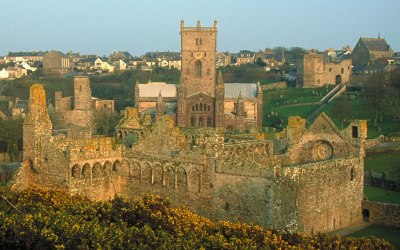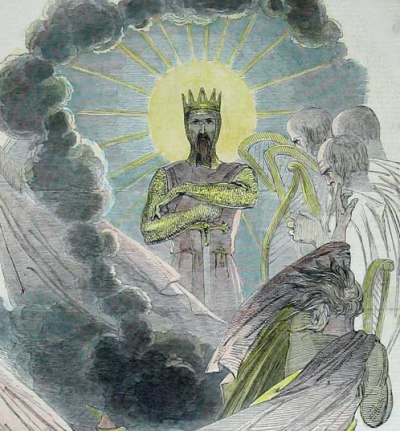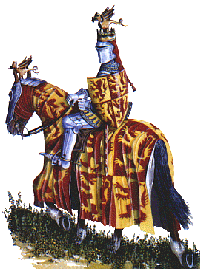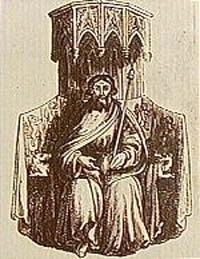The following is an account and history of the three Welsh flags that are currently used throughout Wales.
- The current and most popular Red Dragon Welsh Flag
- The Flag of St. David (Dewi Sant)
- The Owain Glyndwr Flag
Although Wales is an integral part of the UK (represented by the Union Jack), it is still a Nation with it's own identity and therefore still has its own National Flag. It is made up of The Red Dragon (Y Ddraig Goch) of Cadwaladr, King of Gwynedd standing with one foot raised, on a green and white background. As with any ancient symbol, the appearance of the dragon has been adapted and changed over the years, and hence several different variations exist. It must also always be pointing to the left.
The current flag was officially adopted in 1959, and is based on an old royal badge used by since Tudor times which consisted of green and white. The red dragon itself has been associated with Wales for centuries, and as such, the flag is claimed to be the oldest national flag still in use.
As written by Historic UK, the history and heritage accommodation guide;
One legend recalls Romano-British soldiers carrying the red dragon (Draco) to Rome on their banners in the fourth-century, but it could be even older than that.
It is considered that the Welsh kings of Aberffraw first adopted the dragon in the early fifth century in order to symbolise their power and authority after the Romans withdrew from Britain. Later, around the seventh century, it became known as the Red Dragon of Cadwaladr, king of Gwynedd from 655 to 682.
Geoffrey of Monmouth in his Historia Regum Britanniae, written between 1120 and 1129, links the dragon with the Arthurian legends, including Uther Pendragon the father of Arthur whose name translates as Dragon Head. Geoffrey’s account also tells of the prophecy of Myrddin (or Merlin) of a long fight between a red dragon and a white dragon, symbolising the historical struggle between the Welsh (red dragon) and the English (white dragon).
The oldest recorded use of the dragon to symbolise Wales however, is from the Historia Brittonum, written by the historian Nennius around 820.
The red dragon was even said to have been used as the British standard at the Battle of Crecy in 1346, when the Welsh Archers, dressed in their beloved green and white, played such a crucial role in defeating the French.
And although Owain Glyndwr raised the dragon standard in 1400 as a symbol of revolt against the English Crown, the dragon was brought to England by the House of Tudor, the Welsh dynasty that held the English throne from 1485 to 1603. It signified their direct descent from one of the noble families of Wales. The green and white stripes of the flag were additions of Henry VII, the first Tudor king, representing the colours of his standard.
During Henry VIII's reign the red dragon on a green and white background became a favourite emblem on Royal Navy ships.
As the national flag of Wales, the red dragon appears to have regained popularity in the early part of the twentieth century, when it was used for the 1911 Caernarfon Investiture of Edward, Prince of Wales. It wasn't until 1959 however, that it became officially recognised as the national flag of the principality.
The Red Dragon now flies proudly over public and private buildings throughout Wales, and thousands still cross the border into England every other year, when the two nations meet for their ‘historic struggle’ on the Rugby battlefield known as Twickenham. Welshmen, women and children carrying the dragon as a symbol of pride in their history and culture.

The flag of St David is a gold cross on a black background, although earlier variations exist. These include a black cross on a gold field and engrailed edges on the cross.
The cross has been used on occasion as an alternative to Wales' official flag, although it enjoys no such similar status and appears less frequently.
It is the flag for the patron saint of Wales, and bears a similarity to the arms of the diocese of St David's in Pembrokeshire. Indeed, it is most likely to be flown on 1 March, St David's Day which is celebrated by Children and Adults wearing old style Welsh Ladies Costumes, while the males (today) generally wear Welsh Rugby Jerseys and leek badges.
The following was written and published by Historic UK, the history and heritage accommodation guide and is an excellent account of the life of St. David.
David was reputedly born on a cliff top near Capel Non (Non's chapel) on the South-West Wales coast during a fierce storm. Both his parents were descended from Welsh royalty. He was the son of Sandde, Prince of Powys, and Non, daughter of a chieftain of Menevia (now the little cathedral town of St David's). The site of Davids birth is marked by the ruins of a tiny ancient chapel close to a holy well and the more recent 18th century chapel dedicated to his mother Non can still be seen near St. David's Cathedral.

St. Davids Cathedral ©Visit Britain
In medieval times it was believed that St David was the nephew of King Arthur. Legend has it that the patron saint of Ireland, St. Patrick - also said to have been born near the present day city of St. Davids - forsaw the birth of David in approximately 520AD.
The young David grew up to be a priest, being educated at the monastery of Hen Fynyw under the tutorage of St. Paulinus. According to legend David performed several miracles during his life including restoring Paulinus' sight. It is also said that during a battle against the Saxons, David advised his soldiers to wear leeks in their hats so that they could easily be distinguished from their enemies, which is why the leek is one of the emblems of Wales!
A vegetarian who ate only bread, herbs and vegetables and who drank only water, David became known as Aquaticus or Dewi Ddyfrwr (the water drinker) in Welsh. Sometimes, as a self-imposed penance, he would stand up to his neck in a lake of cold water, reciting Scripture! It is also said that milestones during his life were marked by the appearance of springs of water.
Becoming a missionary David travelled throughout Wales and Britain and even made a pilgrimage to Jerusalem where he was consecrated bishop. He founded 12 monasteries including Glastonbury and one at Minevia (St. Davids) which he made his bishops seat. He was named Archbishop of Wales at the Synod of Brevi (Llandewi Brefi), Cardiganshire in 550.
Monastery life was very strict, the brothers having to work very hard, cultivating the land and pulling the plough. Many crafts were followed - beekeeping, in particular, was very important. The monks had to keep themselves fed as well as provide food and lodging for travellers. They also looked after the poor.
St David died on 1 March 589A.D., at Minevia, allegedly over 100 years old. His remains were buried in a shrine in the 6th century cathedral which was ransacked in the 11th century by Viking invaders, who plundered the site and murdered two Welsh bishops.

St. David - Patron Saint of Wales
After his death, his influence spread far and wide, first through Britain and then by sea to Cornwall and Brittany. In 1120, Pope Callactus II canonised David as a Saint. Following this he was declared Patron Saint of Wales. Such was Davids influence that many pilgrimages were made to St. David's, and the Pope decreed that two pilgrimages made to St. Davids equalled one to Rome while three were worth one to Jerusalem. Fifty churches in South Wales alone bear his name.
It is not certain how much of the history of St. David is fact and how much is mere speculation. However in 1996 bones were found in St. David's Cathedral which, it is claimed, could be those of Dewi himself. Perhaps these bones can tell us more about St David: priest, bishop and patron saint of Wales.
VIEW St. Davids Day Gift Collection to Buy HERE!
Owen Glendowr (Owain Glyndwr Flag )

The following is an account by Ben Johnson as is published on the Historic UK, the history and heritage accommodation guide;
The followers of Owen Glendower, the medieval Welsh nationalist leader who disappeared in about 1415, firmly believe that should Wales be in any danger from the English, he would return and free them from oppression.
His name is still remembered and revered today.
Owen Glyn Dŵr, Owen of the Glen of Dee Water, was born around the year 1354, the exact date is unknown. He claimed descent from Llewelyn the Great and the ruling princes of Wales.
He was the heir to two of the four great princely houses of Wales and following his father's death in 1370, received the best education that money could buy in London. He even enjoyed the fashionable 'finishing school' environment provided by the Inns of Court.
 He went on to serve the English Crown as a soldier against the Scots, and wearing a scarlet flamingo feather as his crest he is said to have bore down on the Scotsmen before him with only the butt of his broken lance!
He went on to serve the English Crown as a soldier against the Scots, and wearing a scarlet flamingo feather as his crest he is said to have bore down on the Scotsmen before him with only the butt of his broken lance!
He married the daughter of an Anglo-Welsh judge, fathering six sons with remarkable speed, and led a very peaceful life on his pleasant estates. It was however, in the late 1390's that the seeds of rebellion were sown, following a series of disagreemnets and disputes with the English Crown and Paliament concerning the loss of lands and honour.
And so in September, 1400, when he was 50, Owen organised a rebellion against the recently usurping English king, Henry IV and claimed the title, Prince of Wales.
His popularity appears to have soared almost overnight with Welsh students, seeing in him the leader they had long been looking for, abandening their universitity studies to join him. Welsh labourers threw down their hoes and joined the national uprising. More importantly for Owen, hundreds of seasoned Welsh archers and soldiers, fresh from campaigns in France and Scotland, left English service to join the rebellion.
Owen’s forces spread quickly through northeast Wales. Ruthin, Denbigh, Rhuddlan, Flint, Hawarden, Holt, Oswestry and Welshpool fell quickly. Simultaneously, the Tudor brothers from Anglesey launched a guerrilla war against the English. The Tudors were a prominent Anglesey family and cousins of Owen.
Owen's cause continued to grow fast - in 1401, despite English expeditions into north and south Wales his stature grew as a national hero. The whole of northern and central Wales went over to Owain.
In 1402 the sighting of a great comet in the sky was taken by Owen's followers to be a sign of victory and they captured Owen's enemy Reginald Grey of Ruthin. Grey was later released on the payment of a ransom of £6,666.
Owen was blessed with a sound common sense, and when Edmund Mortimer, the King's nephew was captured, he did not demand a ransom for him, but married him instead to his daughter Catherine. Now Owen was on course for not only the throne of Wales, but for that of England too!
Owen continued to fight the English but after the battle at Woodbury Hill near Worcester in 1405 he retreated back to Wales.
In Wales, Owen issued the Pennal Manifesto on the future of the Welsh Church which was supported by most of the churchmen. It appears that not all of the churchmen were loyal to the end though.
Prior to the battle of Pwll Melyn in 1406, legend has it that a friar had preached with great spirit that all who fell in the fighting would sup that night in heaven! As it became obvious that defeat for Owen's army was in the wind, the friar tried to slip away, however some soldiers caught him and pointed out to him that he was missing the chance of a heavenly banquet; he smartly informed them that this was one of his fast days, and scurried away to safety.
 Following this defeat, one by one, Owen's castles surrendered to the English, his wife and children were captured, and by 1410 he had become a hunted outlaw.
Following this defeat, one by one, Owen's castles surrendered to the English, his wife and children were captured, and by 1410 he had become a hunted outlaw.
Despite the substantial rewards being offered, Owen was never captured or betrayed and his place of hiding remains a mystery to this day. Fragments of information about him kept surfacing, until 1416 when he was believed to have died somewhere, possibly on the estate of his daughters' husband in Herefordshire, ironically in England.
Like the legend of King Arthur, Welsh legend has it that when Wales is threatened again, he will rise in order to lead the defence of Wales. The year 2000 saw the 600th anniversary of of the rising and was commemorated throughout Wales. Owen’s personal standard (the quartered arms of Powys and Deheubarth rampant) can now to be seen all over Wales - especially at rugby matches against the English!

